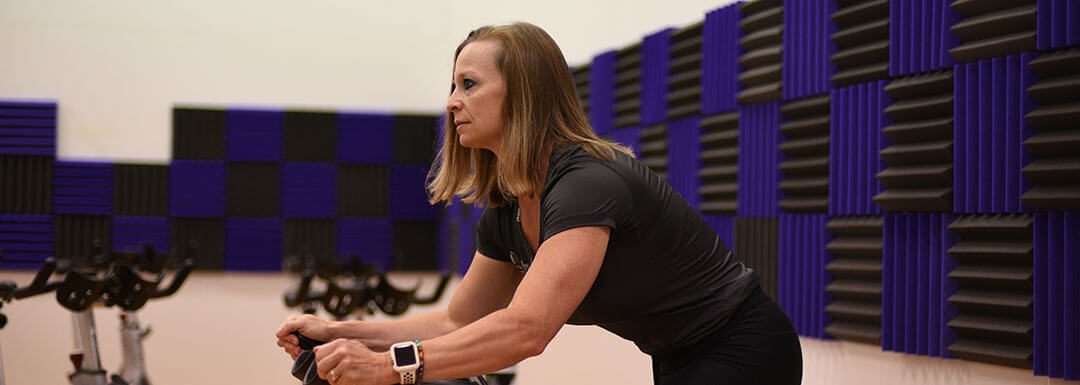Four Core Strength-Training Tips For Cyclists

MUSC personal trainer Nicki Carter says to strengthen the whole body for better overall performance.
Strength Training Tips for Cyclists
MUSC Wellness Center cycling trainer Nicki Carter outlines four key strength-training tips aimed especially at cyclists.
Keep in mind the following strength training terminology when reading the tips below:
- Repetitions (Reps): how many times the exercise is done without resting
- Sets: the number of times you complete a group of repetitions
- Load or Resistance: the weight you are lifting
- Repetition Maximum (RM): the maximum number of times you can lift a given resistance
- Rest or Recovery: the time taken between sets
1. CHOOSE THE APPROPRIATE LOAD & REP RANGES
Whether you are using heavy or light weights, the goal is to use the resistance necessary to reach failure within the rep range you’re aiming for. So, if you’re lifting heavy, use enough resistance that you can barely complete 5 to 8 reps (while maintaining optimal form). If you are lifting light, you want to aim to barely complete 20 reps. Your strength program can and should incorporate both heavy resistance, low rep strength focused work and lower resistance, higher rep muscular endurance focused work. I recommend focusing on heavier weights with less reps in the off season and switching to lighter weights with more reps while in cycling season.
Heavier load training will help to build maximal muscular strength resulting in strength gain and improved performance; however, if you are lifting heavy loads and doing it with improper technique, the injury potential is high. If you are new to strength training, start light and consider consulting a certified personal trainer to coach you safely through proper form.
As previously mentioned, periodize your training so that you have a period of time in your off season dedicated to heavier load, maximal strength building and switch to lighter load, endurance focused strength work while in season. Why? Resistance training with lighter loads carries lower injury risks, which is a big consideration for cyclists who are using resistance training to be a well-rounded athlete and supplement their rides. With lower resistance, athletes are able to maintain proper technique longer as they fatigue.
Strength training aerobically will also create a system that is more resistant to fatigue (muscular endurance) and clears waste products faster. Focus the majority of your base training on lower resistance, higher repetitions, ranging from 15 challenging reps per set up to 25 reps per set for two to four sets. Repetitions above this rep range offer little benefit.
2. TRAIN THE ENTIRE BODY
A balanced body is a better performing machine. Although cycling is predominantly a lower body sport, maintaining a strong upper body and core are also important. A strong core is one of the keys to a long, strong ride. If you don’t keep your core activated and let it get lazy during a ride, your lower back will try to carry the bulk of the load. Don’t forget your arms — your triceps, shoulders and chest can fatigue from holding the handlebars for an extended period. It’s basically the top-of-a pushup position. You need upper-arm strength and endurance. That’s going to help you maintain that upper-body stability when you’re on the bike.
3. BE SELECTIVE & SPECIFIC
Unilateral or bilateral movements?
When choosing strength training exercises, it is important to have a clear understanding of what you want to get out of them. For example, with lunges and squats, both exercises can be used to increase lower body strength, but lunges present a significantly higher balance challenge compared to traditional squats. If stabilization and balance are what you are working on, the lunge is a more effective exercise. You can further increase the balance challenge by using a BOSU ball or another unstable surface. If your goal is building maximum strength to produce maximum force, then traditional squats are a more effective exercise.
Generally speaking a unilateral movement (single leg or single arm at a time) is more effective with less weight and more stability/balance challenge. It is also important to note that when balance/stability/proprioception are your goals, the precision of the movement is crucial and lifting failure does not apply. A bilateral movement (both legs or both arms at once, like a squat or overhead barbell press) is more effective with more weight for maximizing force production.
Cycling is a unilateral movement — each leg is independently doing its part in order to complete a pedal stroke. Single leg exercises, such as lunges and single leg deadlifts, are a great way to be more specific to cycling. Single leg exercises also help correct leg strength imbalances. This does not mean you should not include bilateral movements such as squats. You definitely should! You should just make sure to include unilateral movements in your strength training program as well.
Here are specific exercises for cycling:
- Step ups
- Lunges
- Split squats
- Deadlifts, including single leg deadlifts
- KB Swings
- Squats
- Bridges including single leg bridges
- Back rows (multiple variations)
- Upright rows
- Pushups
- Combo moves such as push-up with renegade row and squat presses
- Planks
- Back extensions
- Pallof cable core presses
4. TRAIN CONSISTENTLY BUT NOT TOO MUCH, NOT TOO LITTLE
More is not always better, and recovery is an important component of training. If you do too much strength training combined with training for an endurance sport, your body will not have enough recovery and you will not see improved performance. For endurance athlete strength training, I typically recommend, two non-consecutive days of full body strength training while in season. For example: Monday and Thursday or Tuesday and Saturday — choose whatever days’ work best while allowing for plenty of recovery. During the off-season, you can opt for 2-4 days of strength training. Consistency is key though — progress results only from consistent efforts.
Get out there and lift!


